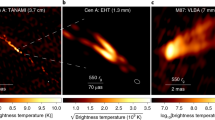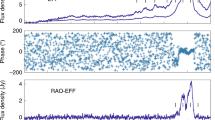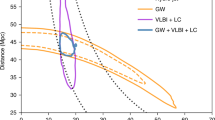Abstract
The afterglow of the binary neutron-star merger GW1708171 gave evidence for a structured relativistic jet2,3,4,5,6 and a link3,7,8 between such mergers and short gamma-ray bursts. Superluminal motion, found using radio very long baseline interferometry3 (VLBI), together with the afterglow light curve provided constraints on the viewing angle (14–28 degrees), the opening angle of the jet core (less than 5 degrees) and a modest limit on the initial Lorentz factor of the jet core (more than 4). Here we report on another superluminal motion measurement, at seven times the speed of light, leveraging Hubble Space Telescope precision astrometry and previous radio VLBI data for GW170817. We thereby obtain a measurement of the Lorentz factor of the wing of the structured jet, as well as substantially improved constraints on the viewing angle (19–25 degrees) and the initial Lorentz factor of the jet core (more than 40).
This is a preview of subscription content, access via your institution
Access options
Access Nature and 54 other Nature Portfolio journals
Get Nature+, our best-value online-access subscription
$29.99 / 30 days
cancel any time
Subscribe to this journal
Receive 51 print issues and online access
$199.00 per year
only $3.90 per issue
Buy this article
- Purchase on Springer Link
- Instant access to full article PDF
Prices may be subject to local taxes which are calculated during checkout




Similar content being viewed by others
Data availability
All HST data used in this work are available via MAST (https://mast.stsci.edu/). The minimum dataset consists of archival HST data from programmes GO-14771, GO-14804 and GO-15329.
Code availability
The hydrodynamical code is currently being prepared for public release and is available from the corresponding authors upon request. All other codes (astrometric and semi-analytical point-source model) used in this work are available at https://github.com/kmooley/GW170817.
References
Abbott, B. P. et al. GW170817: observation of gravitational waves from a binary neutron star inspiral. Phys. Rev. Lett. 119, 161101 (2017).
Mooley, K. P. et al. A mildly relativistic wide-angle outflow in the neutron-star merger event GW170817. Nature 554, 207–210 (2018).
Mooley, K. P. et al. Superluminal motion of a relativistic jet in the neutron-star merger GW170817. Nature 561, 355–359 (2018).
Ghirlanda, G. et al. Compact radio emission indicates a structured jet was produced by a binary neutron star merger. Science 363, 968–971 (2019).
Hajela, A. et al. Two years of nonthermal emission from the binary neutron star merger GW170817: rapid fading of the jet afterglow and first constraints on the kilonova fastest ejecta. Astrophys. J. Lett. 886, L17 (2019).
Troja, E. et al. A thousand days after the merger: continued X-ray emission from GW170817. Mon. Not. R. Astron. Soc. 498, 5643–5651 (2020).
Abbott, B. P. et al. Gravitational waves and gamma-rays from a binary neutron star merger: GW170817 and GRB 170817A. Astrophys. J. Lett. 848, L13 (2017).
Fong, W. et al. The electromagnetic counterpart of the binary neutron star merger LIGO/Virgo GW170817. VIII. A comparison to cosmological short-duration gamma-ray bursts. Astrophys. J. Lett. 848, L23 (2017).
Gaia Collaboration Gaia Data Release 2. Summary of the contents and survey properties. Astron. Astrophys. 616, A1 (2018).
Gaia Collaboration Gaia Early Data Release 3. Summary of the contents and survey properties. Astron. Astrophys. 649, A1 (2021).
Cantiello, M. et al. A precise distance to the host galaxy of the binary neutron star merger GW170817 using surface brightness fluctuations. Astrophys. J. Lett. 854, L31 (2018).
Hjorth, J. et al. The distance to NGC 4993: the host galaxy of the gravitational-wave event GW170817. Astrophys. J. Lett. 848, L31 (2017).
Mooley, K. P. et al. A strong jet signature in the late-time lightcurve of GW170817. Astrophys. J. Lett. 868, L11 (2018).
Makhathini, S. et al. The panchromatic afterglow of GW170817: the full uniform data set, modeling, comparison with previous results, and implications. Astrophys. J. 922, 154 (2021).
Gill, R., Granot, J., De Colle, F. & Urrutia, G. Numerical simulations of an initially top-hat jet and the afterglow of GW170817/GRB170817A. Astrophys. J. 883, 15 (2019).
Lamb, G. P., Levan, A. J. & Tanvir, N. R. GRB 170817A as a refreshed shock afterglow viewed off-axis. Astrophys. J. 899, 105 (2020).
Blandford, R. D. & McKee, C. F. Fluid dynamics of relativistic blast waves. Phys. Fluids 19, 1130–1138 (1976).
Beniamini, P., Granot, J. & Gill, R. Afterglow light curves from misaligned structured jets. Mon. Not. R. Astron. Soc. 493, 3521–3534 (2020).
Granot, J. & Kumar, P. Constraining the structure of gamma-ray burst jets through the afterglow light curves. Astrophys. J. 591, 1086–1096 (2003).
Lu, W., Beniamini, P. & McDowell, A. Deceleration of relativistic jets with lateral expansion. Preprint at https://arxiv.org/abs/2005.10313 (2020).
Lithwick, Y. & Sari, R. Lower limits on Lorentz factors in gamma-ray bursts. Astrophys. J. 555, 540–545 (2001).
Nakar, E. Short-hard gamma-ray bursts. Phys. Rep. 442, 166–236 (2007).
Ghirlanda, G. et al. Bulk Lorentz factors of gamma-ray bursts. Astron. Astrophys. 609, A112 (2018).
Matsumoto, T., Nakar, E. & Piran, T. Generalized compactness limit from an arbitrary viewing angle. Mon. Not. R. Astron. Soc. 486, 1563–1573 (2019).
Hotokezaka, K. et al. A Hubble constant measurement from superluminal motion of the jet in GW170817. Nat. Astron. 3, 940–944 (2019).
Fender, R. in Compact Stellar X-ray Sources (eds Lewin, W. & van der Klis, M.) Cambridge Astrophysics Series, No. 39, 381–420 (Cambridge Univ. Press, 2006).
Lister, M. L. et al. MOJAVE. X. Parsec-scale jet orientation variations and superluminal motion in active galactic nuclei. Astron. J. 146, 120 (2013).
Mattila, S. et al. A dust-enshrouded tidal disruption event with a resolved radio jet in a galaxy merger. Science 361, 482–485 (2018).
VizieR Online Data Catalog: Gaia EDR3 I/350 (Gaia Collaboration, 2020); https://vizier.u-strasbg.fr/viz-bin/VizieR-3?-source=I/350/gaiaedr3
Anderson, J. Empirical Models for the WFC3/IR PSF Space Telescope WFC Instrument Science Report (2016).
Bellini, A., Anderson, J. & Bedin, L. R. Astrometry and photometry with HST WFC3. II. Improved geometric-distortion corrections for 10 filters of the UVIS channel. Publ. Astron. Soc. Pac. 123, 622 (2011).
Dobie, D. et al. A turnover in the radio light curve of GW170817. Astrophys. J. Lett. 858, L15 (2018).
Alexander, K. D. et al. A decline in the X-Ray through radio emission from GW170817 continues to support an off-axis structured jet. Astrophys. J. Lett. 863, L18 (2018).
Troja, E. et al. The outflow structure of GW170817 from late-time broad-band observations. Mon. Not. R. Astron. Soc. 478, L18–L23 (2018).
Lamb, G. P. et al. The optical afterglow of GW170817 at one year post-merger. Astrophys. J. Lett. 870, L15 (2019).
Fong, W. et al. The optical afterglow of GW170817: an off-axis structured jet and deep constraints on a globular cluster origin. Astrophys. J. Lett. 883, L1 (2019).
Piro, L. et al. A long-lived neutron star merger remnant in GW170817: constraints and clues from X-ray observations. Mon. Not. R. Astron. Soc. 483, 1912–1921 (2019).
Greisen, E. W. in Information Handling in Astronomy—Historical Vistas Astrophysics and Space Science Library Vol. 285 (ed. Heck, A.) 109–125 (Springer, 2003).
Radio Fundamental Catalog (Astrogeo Center, 2022); http://astrogeo.org/rfc/
Walker, R. C. The SCHED User Manual Version 11.7 (NRAO, 2022); http://www.aoc.nrao.edu/software/sched
A SCHED Source Catalog (NRAO, 2021); http://www.vlba.nrao.edu/astro/calib/sources_allfreq.icrf3
Pradel, N., Charlot, P. & Lestrade, J.-F. Astrometric accuracy of phase-referenced observations with the VLBA and EVN. Astron. Astrophys. 452, 1099–1106 (2006).
Radio Fundamental Catalog version rfc_2021b (Astrogeo Center, 2021); http://astrogeo.org/sol/rfc/rfc_2021b
Kovalev, Y. Y., Petrov, L. & Plavin, A. V. VLBI-Gaia offsets favor parsec-scale jet direction in active galactic nuclei. Astron. Astrophys. 598, L1 (2017).
Petrov, L. & Kovalev, Y. Y. On significance of VLBI/Gaia position offsets. Mon. Not. R. Astron. Soc. 467, L71–L75 (2017).
Petrov, L., Kovalev, Y. Y. & Plavin, A. V. A quantitative analysis of systematic differences in the positions and proper motions of Gaia DR2 with respect to VLBI. Mon. Not. R. Astron. Soc. 482, 3023–3031 (2019).
Charlot, P. et al. The third realization of the International Celestial Reference Frame by very long baseline interferometry. Astron. Astrophys. 644, A159 (2020).
Gaia Collaboration Gaia Data Release 2. The Celestial Reference Frame (Gaia-CRF2). Astron. Astrophys. 616, A14 (2018).
Liu, J. C., Zhu, Z. & Liu, N. Link between the VLBI and Gaia reference frames. Astron. J. 156, 13 (2018).
Liu, N., Lambert, S. B., Zhu, Z. & Liu, J. C. Systematics and accuracy of VLBI astrometry: a comparison with Gaia Data Release 2. Astron. Astrophys. 634, A28 (2020).
Deller, A. et al. LIGO/Virgo G298048: milliarcsecond imaging o f the NGC 4993 central radio source. GRB Coordinates Network 21897 (2017).
Granot, J., Miller, M., Piran, T., Suen, W. M. & Hughes, P. A. in Gamma-ray Bursts in the Afterglow Era (eds Costa, E. et al.) 312–315 (Springer, 2001).
Kumar, P. & Granot, J. The evolution of a structured relativistic jet and gamma-ray burst afterglow light curves. Astrophys. J. 591, 1075–1085 (2003).
Zhang, W. & MacFadyen, A. The dynamics and afterglow radiation of gamma-ray bursts. I. Constant density medium. Astrophys. J. 698, 1261–1272 (2009).
van Eerten, H., Zhang, W. & MacFadyen, A. Off-axis gamma-ray burst afterglow modeling based on a two-dimensional axisymmetric hydrodynamics simulation. Astrophys. J. 722, 235–247 (2010).
De Colle, F., Ramirez-Ruiz, E., Granot, J. & Lopez-Camara, D. Simulations of gamma-ray burst jets in a stratified external medium: dynamics, afterglow light curves, jet breaks, and radio calorimetry. Astrophys. J. 751, 57 (2012).
Duffell, P. C. & Laskar, T. On the deceleration and spreading of relativistic jets. I. Jet dynamics. Astrophys. J. 865, 94 (2018).
Fernández, J. J., Kobayashi, S. & Lamb, G. P. Lateral spreading effects on VLBI radio images of neutron star merger jets. Mon. Not. R. Astron. Soc. 509, 395–405 (2022).
Kumar, P. & Zhang, B. The physics of gamma-ray bursts & relativistic jets. Phys. Rep. 561, 1–109 (2015).
Margutti, R. et al. The binary neutron star event LIGO/Virgo GW170817 160 days after merger: synchrotron emission across the electromagnetic spectrum. Astrophys. J. Lett. 856, L18 (2018).
Foreman-Mackey, D., Hogg, D. W., Lang, D. & Goodman, J. emcee: the MCMC hammer. Publ. Astron. Soc. Pac. 125, 306–312 (2013).
Takahashi, K. & Ioka, K. Inverse reconstruction of jet structure from off-axis gamma-ray burst afterglows. Mon. Not. R. Astron. Soc. 497, 1217–1235 (2020).
Zhang, B. & Mészáros, P. Gamma-ray burst beaming: a universal configuration with a standard energy reservoir? Astrophys. J. 571, 876–879 (2002).
Rossi, E., Lazzati, D. & Rees, M. J. Afterglow light curves, viewing angle and the jet structure of γ-ray bursts. Mon. Not. R. Astron. Soc. 332, 945–950 (2002).
Gottlieb, O., Nakar, E. & Bromberg, O. The structure of hydrodynamic γ-ray burst jets. Mon. Not. R. Astron. Soc. 500, 3511–3526 (2021).
Ramirez-Ruiz, E., Andrews, J. J. & Schrøder, S. L. Did GW170817 harbor a pulsar? Astrophys. J. Lett. 883, L6 (2019).
Panaitescu, A. & Kumar, P. Properties of relativistic jets in gamma-ray burst afterglows. Astrophys. J. 571, 779–789 (2002).
Nakar, E., Piran, T. & Granot, J. The detectability of orphan afterglows. Astrophys. J. 579, 699–705 (2002).
kmooley / GW170817. GitHub https://github.com/kmooley/GW170817/ (2021).
Speagle, J. S. DYNESTY: a dynamic nested sampling package for estimating Bayesian posteriors and evidences. Mon. Not. R. Astron. Soc. 493, 3132–3158 (2020).
Abbott, B. P. et al. A gravitational-wave standard siren measurement of the Hubble constant. Nature 551, 85–88 (2017).
Cowperthwaite, P. S. et al. The electromagnetic counterpart of the binary neutron star merger LIGO/Virgo GW170817. II. UV, optical, and near-infrared light curves and comparison to kilonova models. Astrophys. J. Lett. 848, L17 (2017).
Tanvir, N. R. et al. The emergence of a lanthanide-rich kilonova following the merger of two neutron stars. Astrophys. J. Lett. 848, L27 (2017).
Hajela, A. et al. Evidence for X-ray emission in excess to the jet-afterglow decay 3.5 yr after the binary neutron star merger GW 170817: a new emission component. Astrophys. J. Lett. 927, L17 (2022).
Troja, E. et al. Accurate flux calibration of GW170817: is the X-ray counterpart on the rise? Mon. Not. R. Astron. Soc. 510, 1902–1909 (2022).
Balasubramanian, A. et al. Continued radio observations of GW170817 3.5 yr post-merger. Astrophys. J. Lett. 914, L20 (2021).
Villar, V. A. et al. The combined ultraviolet, optical, and near-infrared light curves of the kilonova associated with the binary neutron star merger GW170817: unified data set, analytic models, and physical implications. Astrophys. J. Lett. 851, L21 (2017).
Acknowledgements
We thank A. Deller for pointing out the required correction for radio VLBI positions, for reading of the manuscript and for providing comments. K.P.M. thanks A. Krone-Martins for discussions, D. Frail for commenting on an early version of this manuscript and Y. Mooley for help with the Nature submission. K.P.M. is indebted to K. Gaura-Nitay for providing the impetus to execute this project. This research is based on observations made with the NASA/ESA Hubble Space Telescope obtained from the Space Telescope Science Institute, which is operated by the Association of Universities for Research in Astronomy, Inc., under NASA contract NAS 5-26555. These observations are associated with HST programmes GO-14771, GO-14804 and GO-15329. K.P.M. was a Jansky Fellow of the National Radio Astronomy Observatory and his work is currently supported through the National Research Foundation Grant AST-1911199. W.L. was supported by the David and Ellen Lee Fellowship at Caltech and Lyman Spitzer, Jr Fellowship at Princeton University.
Author information
Authors and Affiliations
Contributions
J.A. led the HST analysis. W.L. set up the semi-analytical and hydrodynamical models. K.P.M. led the scientific analysis and interpretation. All authors discussed and wrote the paper.
Corresponding authors
Ethics declarations
Competing interests
The authors declare no competing interests.
Peer review
Peer review information
Nature thanks Elena Pian and the other, anonymous, reviewer(s) for their contribution to the peer review of this work. Peer reviewer reports are available.
Additional information
Publisher’s note Springer Nature remains neutral with regard to jurisdictional claims in published maps and institutional affiliations.
Extended data figures and tables
Extended Data Fig. 1 Selection of Gaia reference stars for the F160W analysis.
The panels (a), (b) give the positions, magnitudes and positional uncertainties (1σ) associated with the 32 Gaia stars that are within the WFC3/IR frame, which is shown in panel (c). The legend shows the marker shape and colour used for plotting these stars based on their vetted classifications. The 6 Gaia reference stars selected based on low quoted Gaia positional errors, distant location from the host galaxy nucleus (>12 arcseconds from the nucleus of NGC 4993), centroid located on the HST chip, and away from any bad pixels, are shown as black filled circles. In panels (a), (c) the blue dashed lines denote the 12 arcsecond distance constraint from the NGC 4993 nucleus, and the green dashed lines denote the extent of the WFC3/IR chip.
Extended Data Fig. 2 Residuals from the distortion correction for WFC3/IR.
The distortion residuals along each axis (image X/Y) for image slices that are 50-pixels wide in the orthogonal direction (see Methods for details). The X residuals are shown in panel (a) and the Y residuals in panel (b). The horizontal axis in each panel represents the pixel number and the vertical axis represents the residual in units of pixels. Each set of red and black curves, as well as each data point plotted on the red and black curves, represents one slice (offset of each set of curves along the vertical axis is arbitrary). The black points/curves denote the distortion residuals after the standard HST distortion correction30 and the red after our improved correction. In general, the residuals went down by a factor of two in each coordinate after the application of the improved correction. The new distortion-correction residuals lie within 0.002 pixel per coordinate (i.e. within 0.08 mas; root mean square).
Extended Data Fig. 3 HST/Gaia merger position of GW170817.
The positions of GW170817 in the individual HST F160W exposures (blue filled and red unfilled circles; mean epoch 8 d post-merger) and the combined HST position (black star), in the Gaia pixelized frame, shown along with the radio VLBI measurements3 at 75 d and 230 d. The error bars represent 1σ statistical uncertainties. The VLBI systematic uncertainties have not been included.
Extended Data Fig. 4 Full posterior from the hydrodynamic simulations.
The parameters are: peak Lorentz factor \({\rm{lg}}{u}_{0,\max }\), angular size of the jet core lgθc [rad], power-law index q for the energy distribution of the jet wing, power-law index s for the Lorentz factor distribution of the jet wind, magnetic field equipartition parameter lgϵB, power-law index p for the electron Lorentz factor distribution, lgEiso/n0[erg cm3] — ratio between the isotropic equivalent energy on the jet axis and the circumstellar medium number density, inclination angle θv [degree] between the line of sight and the jet axis, luminosity distance to the source DL. The dashed lines in the marginalized probability distributions indicate the 90% credible interval for each parameter.
Supplementary information
Rights and permissions
Springer Nature or its licensor holds exclusive rights to this article under a publishing agreement with the author(s) or other rightsholder(s); author self-archiving of the accepted manuscript version of this article is solely governed by the terms of such publishing agreement and applicable law.
About this article
Cite this article
Mooley, K.P., Anderson, J. & Lu, W. Optical superluminal motion measurement in the neutron-star merger GW170817. Nature 610, 273–276 (2022). https://doi.org/10.1038/s41586-022-05145-7
Received:
Accepted:
Published:
Issue Date:
DOI: https://doi.org/10.1038/s41586-022-05145-7
This article is cited by
-
Science with a Small Two-Band UV-Photometry Mission I: Mission Description and Follow-up Observations of Stellar Transients
Space Science Reviews (2024)
-
Spherical symmetry in the kilonova AT2017gfo/GW170817
Nature (2023)
Comments
By submitting a comment you agree to abide by our Terms and Community Guidelines. If you find something abusive or that does not comply with our terms or guidelines please flag it as inappropriate.



